Introduction
As a person, who regularly exercises and shows a great deal of interest in fitness and sports sciences, I am personally engaged in the topic of proper resting and muscle recovery. It is important to illuminate the underlying mechanism behind exercises and body’s capacity for sufficient recovery in order to make sustained and continuous gains. Although the current literature has information on the lifestyle-related recovery, such as sleep, there is no significant data on the immediate resting performed during the exercise session. Many vigorous exercise activities are conducted within the framework of sets, between which, I, as many others, usually have a short rest. However, there is no clear evidence on how to spend this short resting and recovery phase, because some prefer standing or sitting, whereas others walk. Therefore, the topic and the experimental design are directly inspired by my own engagement and involvement in this endeavor.
Research Question: Resting Position and Recovery
All living cells need a continuous supply of energy that is used for a wide range of processes including active transport and protein synthesis. The body’s activities normally require the power in the form of ATP, adenosine triphosphate that is produced by every cell through respiration. ATP is always available as energy in the cell and has the potential to diffuse to any part of the cell and release its energy within a fraction of a second. Lactase production in humans when anaerobic respiration is used to maximize the power of muscle contractions. Anaerobic cell respiration is used in muscles carrying very vigorous exercise. Lactate (Lactic Acid) and hydrogen ions can only be used to create ATP for about only two minutes. After vigorous exercise, the human body must develop an effective recovery mechanism to replace ATP used, remove lactic acid, and replenish myoglobin with oxygen as well as substituting glycogen. The purpose of this is to restore the body to its pre-exercise condition, and it may take a shorter or longer time depending on the intensity of the duration of the activity.
The independent variable is a resting position, whereas the dependent variable is pulse rate with participants being Homo Sapiens. Different people require excellent strategies to reduce recovery time after rigorous activities. This is aided by the respiratory system which plays an important role during the exercise and rest periods. It mitigates metabolic by-products such as hydrogen and carbon dioxide to help maintain the acid-base homeostasis and reduce dysregulation of the excitation-contraction coupling process in localized muscle tissue. Thus, when ventilation is increased, the tidal capacity of enhanced, which conserves the respiratory rate leading to effective breathing (Michaelson et al. 24). Studies have in the past investigated the effect of different resting postures on recovery after intense physical activities. A number of studies have focused on supine, sitting down, and standing with the upright position being the most commonly used recovery posture, particularly for the athletes. Further, resting position may influence autonomic function which leads to a quicker recovery. Therefore, the research question is as follows:
- What is the effect of different resting positions (sitting down, supine, walking and standing) on the recovery time of the pulse rate (age, male/ female e.g. 16-year-old females) after high-intensity exercises?
Variables
The dependent variable is pulse rate, the independent variable is a resting position, and the controlled variable include exercises. The independent variable is altered by instructing to rest within a specific position, such as sitting or standing. The dependent variable is measured by calculating the heart or pulse rate per minute. The controlled variable includes only exercises, which are controlled by keeping them of the same intensity and format, and no participant will perform exercises different than the others.
Hypothesis
The research question was formulated with a null hypothesis that: there is no effect of different resting positions (sitting down, supine, walking, and standing) on the recovery time of the pulse rate after high-intensity exercises. The alternative hypothesis was that: different resting positions (sitting down, supine, walking, and standing) have an effect on the recovery time of the pulse rate after high-intensity exercises. Therefore, the dependent variable included the pulse rate, but the independent variable was the selected resting position. In the event that the findings are not statistically significant, the study will fail to reject the null hypothesis. On the other hand, if the results prove to be significant, the alternative hypothesis will be validated. The correct answer is that the resting position has no impact of recovery, while the similar relationship was initially predicted.
Background
All living cells need a continuous supply of energy. This energy is used for a wide range of processes including active transport and protein synthesis. Most of these processes require energy in the form of ATP, adenosine triphosphate. Every cell produces its own ATP, by a process called cell respiration. Carbon compounds (organic compounds) such as glucose or fat are carefully broken down and the energy released by doing this is used to make ATP. Cell respiration is defined as the controlled release of energy from organic compounds to produce ATP. The advantage of ATP is that it is immediately available as an energy in the cell. It can diffuse to any part of the cell and release its energy within a fraction of a second. Lactase production in humans when anaerobic respiration is used to maximize the power of muscle contractions. Anaerobic cell respiration is used in muscles carrying very vigorous exercise. Lactate (Lactic Acid) and hydrogen ions can only be used to produce ATP for about only two minutes. Beyond this duration, hydrogen ions, so aerobic cell respiration must be used and high-intensity exercise cannot be continued.
A null hypothesis was that there is no effect of different resting positions (sitting down, supine, walking, and standing) on the recovery time of the pulse rate after high-intensity exercises. The alternative hypothesis was that different resting positions (sitting down, supine, walking, and standing) have an effect on the recovery time of the pulse rate after high-intensity exercises. The resting position is the independent variable, whereas the pulse rate is the dependent variable. The design allows the researcher to measure the outcome and the exposures in the study participants at the same time (Setia 263). The basic metabolic panel (BMP) of all the participants was measured immediately after the exercise. This was necessary to evaluate different substances in the bodies of the partakers to have knowledge about important information about their body’s chemical balance and metabolism (Jewell par. 3). The findings of the study by Van de Vegte, Van der Harst and Verweij, who investigated the reduction of heart rate 1 minute after cessation of physical activities (1). Therefore, there is strong evidence and support for the selected topic of research as well as the experimental design selected.
There are two stages of recovery; the rapid recovery stage (Alactacid Debt) where the elevated respiration assist resynthesize the muscles’ store of ATP thereby replenishing the muscle stores of myoglobin and hemoglobin. Alactacid debt usually takes 3 minutes for ATP to recover fully in about 30 seconds 50% of healing and about 75% redemption in 60 seconds (WJEC CBAC par. 5). Further, Alactacid debt (slow recovery stage) is credited for the removal of lactic acid. It uses about 5-8 liters of oxygen and can extract the acid for a period of between 1 to 24 hours depending on the intensity of the exercise (WJEC CBAC par. 7). Several methods including resting are used to speed up the recovery process (Polar par. 5). This paper will therefore assess the effect of different resting positions on the recovery time after vigorous exercise. It tried to discuss the impact of standing, supine, walking, and sitting down and their relationship with age and gender on the pulse rate after high-intensity activities.
Methodology: Control of the Variables
The body mass index (BMI) for each participant was taken against their identities and ages. Participants A, B, C, D, and E recorded 18, 19, 29, 21, and 3 BMIs respectively. Further, the basic metabolic panel (BMP) of all the participants was measured immediately after the exercise. This was necessary to evaluate different substances in the bodies of the partakers to have knowledge about important information about their body’s chemical balance and metabolism (Jewell par. 7). The resting heart rate BMP results were 86, 75, 89, 78, and 65 in their respective order of identification index. Additionally, the maximum heart rate BMP post-exercise for A, B, C, D, and E were 176, 182, 172, 180, and 156.
Thereafter, the estimates of the participants’ recovery positions HR when standing, supine, walking, and sitting were recorded after 1 minute, 3 minutes, and 5 minute intervals. The data was then used to compute the initial resting recovery position HR against the final redemption posture HR when standing, supine, walking, and sitting respectively. The effects of different recovery orientations on the time of pulse rate were then analyzed after 1, 3, and 5 minutes.
Methodology: Data Collection
This study used a cross-sectional to investigate the topic and the question it set to answer. A cross-sectional study is defined as a type of observational research that analyzes data of variables collected at one given point in time across a sample population or a pre-defined subset. The design allows the researcher to measure the outcome and the exposures in the study participants at the same time (Setia 263). The candidates for the test are selected according to the inclusion and exclusion criteria set out by the investigator. Once included, the outcomes are recorded and the researcher uses the findings to formulate the relationships between the variables under study (Setia 264). This type of design is relatively easier and faster to conduct and not expensive in terms of the resources required. However, it is difficult to derive causal relationships because it is one-time testing of the outcome of an event being observed.
A sample of five participants was enrolled for this research. In terms of gender, 3 males and 2 females were recruited to take part in the investigation of the effect of different resting positions such as standing, supine, walking, and sitting down, on the recovery time of the pulse rate after vigorous exercise. Age factor was considered with two being 13, and the others being 19, 45, and 56 years old respectively.
Analysis: Data Collection
The data gathered after conducting the tests on the participants’ initial resting positions, and their recovery postures HR when standing, supine, walking, and sitting were screened, and coded for analysis using SPSS package version 28. Thereafter, followed analysis was done descriptively in the form of percentages presented in charts and inferentially using the analysis of variance (ANOVA) test. It determines whether there is a statistically significant difference between the means of two or more groups that are independent and unrelated (Simkus par. 4). In this study, the independent variable was resting after intense exercise, which had groups or levels such as standing, supine, walking, and sitting positions. The test statistics for ANOVA F (that is variance caused by treatment/variance due to random chance). The confidence interval was set at 95%, with the significance level being 5% or 0.05 (Simkus par. 5). Therefore, a p-value < 0.05 when the F is greater than 1 reveals a significant statistical difference between the means of the groups (Simkus par. 7). Meaning that the difference could be due to chance, and the raw data is presented in Tables 1, 2, and 4 below.

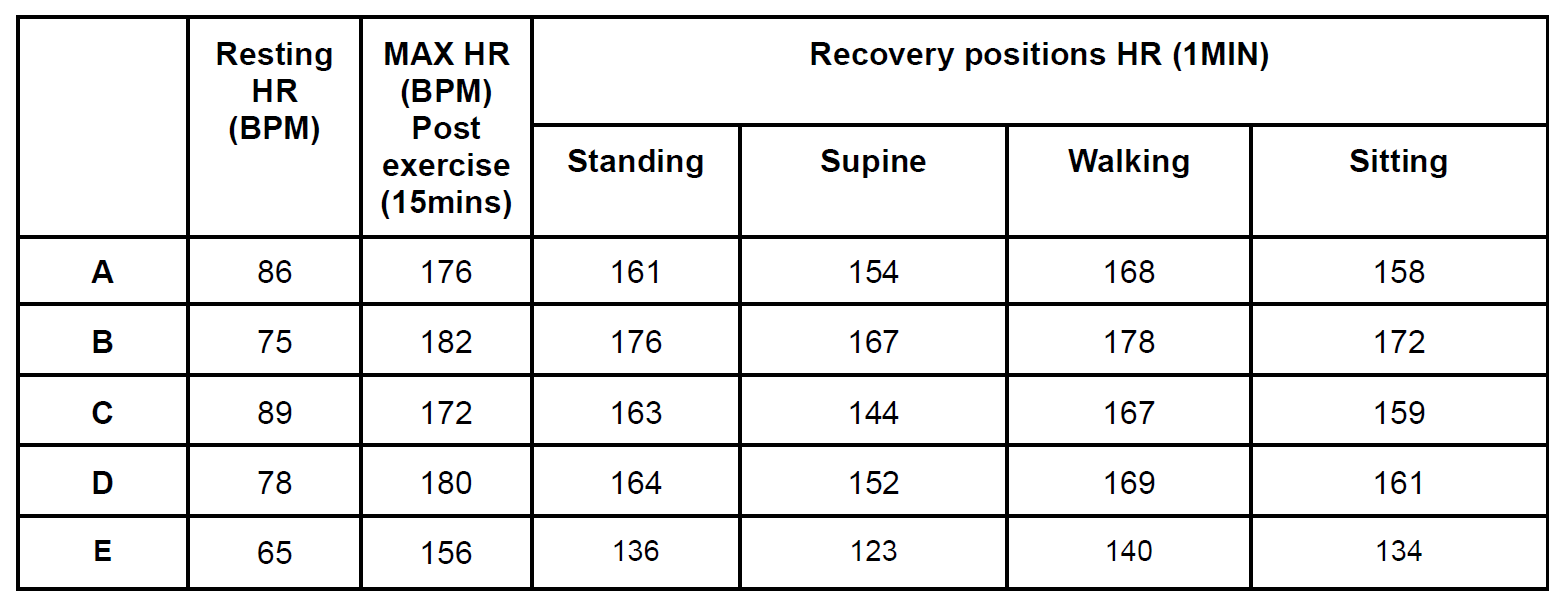
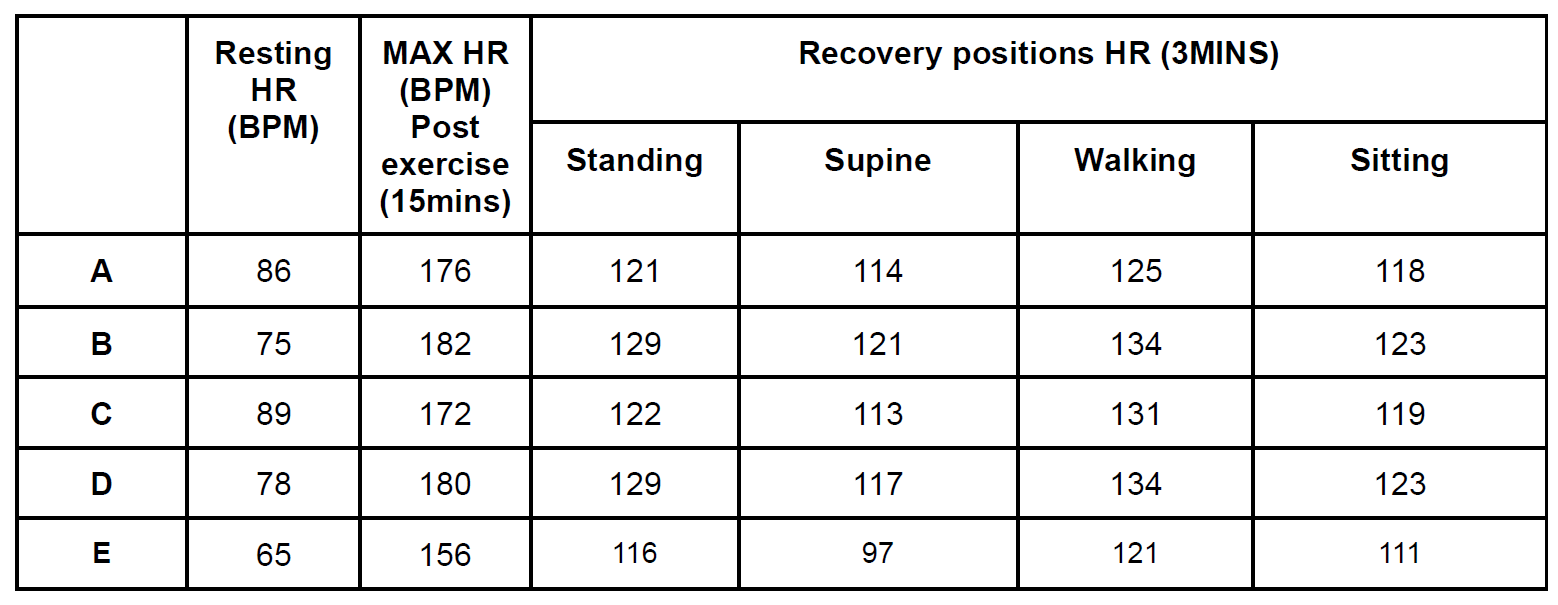
Processing Data
The recovery time of the pulse rate after I minute for standing position were A = 75, B = 101, C = 74, D = 86, E = 71. On average the five participants while upright had a mean recovery HR of 81.4 ± 12.34. For supine pulse rate after a minute were A = 68, B = 92, C = 55, D = 75, E = 58, with a combined mean of 69.4 ± 14.76. On the other hand, the pulse rate for walking posture were A = 82, B = 103, C = 78, D = 91, E = 78, with a mean of 85.8 ±. In addition, the pulse rate after a minute for sitting position were A = 72, B = 97, C = 70, D = 83, E = 69, and the combined group meanwhile sitting was 72.2 ± 11.90. Looking at this trend it is evident that the walking position of resting had the best or the highest recovery HR after 1 minute followed closely by standing posture. When participants were seated came third, while supine was fourth and the last.
Further, it seems that age and gender were not major factors contributing to variation in recovery HR time across all the participants. This is proved by the fact that candidates A and B were of the same gender and equally of the same age but B always had the highest recovery HR in all resting positions than A. Additionally, partaker B had the best HR rate after 1 minute of all the other participants in all the categories of relaxation.

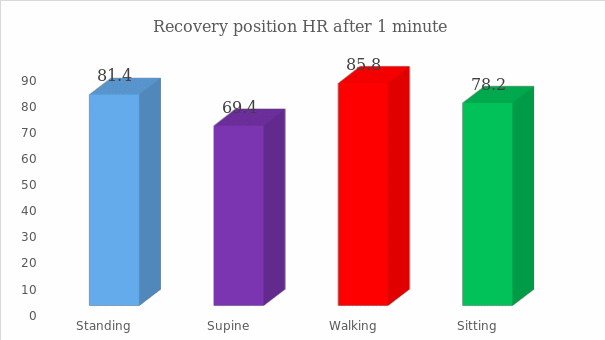
After 3 minutes the recovery time HR for standing posture were A = 35, B = 54, C = 33, D = 51, E = 51, and the combined group mean was 44.8 ± 9.96. For supine position, pulse rates were A = 28, B = 46, C = 24, D = 39, E = 32, and the group mean was 33.8 ± 8.79. In contrast, the walking position had participants ratings as follows, A = 39, B = 59, C = 42, D = 56, E = 56, with a category mean of 50.4 ± 9.18. The results for the sitting mode of resting showed that A, B, C, D, and E had pulse rates of 32, 48, 30, 45, and 46 respectively. Collectively the participants’ mean recovery HR was 40. 2 ± 8.5. Interestingly, respondent B registered the highest recovery HR in all positional categories. In terms of the redemption positions, after 3 minutes of HR walking was still the best followed by standing at second with sitting and supine coming third and fourth.
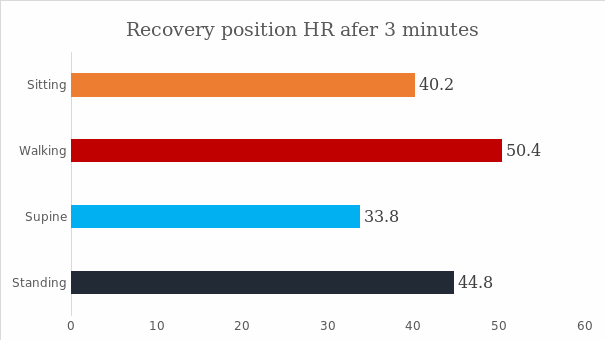
When the process of recovery time HR was repeated after 5 minutes, the participants score the following while standing, A = -5, B = – 2, C = – 3, D = 9, E = 13, and their mean was 2.4 ± 8.05. The healing rates for the respondents for supine were A = – 8, B = – 6, C = – 16, D – 2, E – 2, with a combined mean of – 6.8 ± 7. 56. In addition, while walking participants A, B, C, D, and E had 6, 6, 1, 17, and 16 counts separately, however, their collective average outcome was 9.2 ± 6.99. Lastly, the ratings for the participants in terms of sitting mode were A = 1, B = 1, C = -8, D = 6, E = 8, with a group mean of 6. 19. Like the other two pulse rates after 1 and 3 minutes, the walking position equally had the highest recovery rate compared to sitting, and supine.
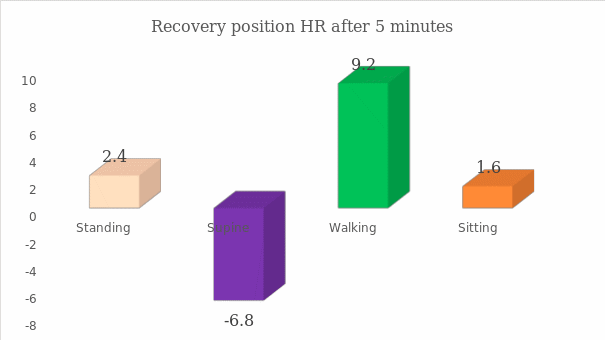
Presenting Data
The investigations of the effects of different resting positions revealed a pattern in that the recovery time of the pulse rate after intense exercise was high when the time was shorter. After 1 minute all the relaxation positions of standing, walking, sitting, and supine had the highest ratings collective mean of 77.2. However, there was a sharp decline in the recovery time HR when the test was run after 3 minutes as all the four positions combined had an average of 42.4. Further, there was a continued downtrend in the ratings when the measurements were taken after 5 minutes with a mean of 1.6. This was even worse for standing, sitting, and supine positions which registered negative scores. Only the walking relaxation posture maintained positive counts for all the participants but was lower than the effects after 1 and 3 minutes.
Another curious trend emerged when the trends were analyzed further. Participant B who had the highest scores after 1 minute and 3 minutes, dropped drastically in ratings and recorded negative counts for standing and supine positions. Whereas, the respondent D and E registered relatively higher HR for walking, standing, and sitting categories. The findings revealed that different resting positions influenced the recovery time of the pulse rate after vigorous exercise. In particular, walking and standing had the best and second best effects on the recovery HR time while sitting and supine had the least impact on the redemption time after intense activities. It was evident from the results that time variation of measuring recovery HR determines the decrease levels after termination of the vigorous exercises. Higher HR for all the resting positions was recorded after the first minute interval.
The subsequent testing that was done after 3 minutes indicated a much-reduced score. This is in line with the findings of the study by Van de Vegte, Van der Harst and Verweij (2018) who investigated the reduction of heart rate 1 minute after cessation of physical activities (2). Further, when the participants were subjected to another series of measurements after 5 minutes, the decline in HR was drastically lower with candidates’ scores registering negative for standing, supine, and sitting positions.
Their study focused on the prognostic value of HR at 10, 20, 30, 40, and 50 seconds after the termination of exercise. They examined 40727 participants from the UK Biobank (Van de Vegte, Van der Harst, and Verweij 4). The average age of the respondents was 56 years with 56% of them being females, while 45% were males. The outcomes of this research were on HR was higher and more significant when the measurements were recorded immediately or earlier after the physical exercise (Van de Vegte, Van der Harst, and Verweij 5). They concluded by saying that there was sufficient proof that decreased HR at 10 seconds after cessation of exercises is a strong predictor of the results than when HR is taken at a later time interval.
Another peculiar observation was the fact that participant B registered higher scores across all the spectrum of positions and at 1 minute, 3 minute, and five minute intervals. Whereas candidate A, who was of the same age registered lower counts. This could be related to the genetic composition of the partakers of the study. The genome is known to be one of the factors impacting the HR (Polar par. 6). It has been proven that due to gene effect HR, two individuals of the same age could have a difference of more than 20 beats per minute despite having the same level of fitness. A further contradiction of this finding with other evidence available was that, as people grow older, their HR usually increases because of their reduced level of physical vigor.
Conclusion
In conclusion, recovery is an important aspect of any fitness progression. An exercise, especially a vigorous one, always needs to be accompanied by proper rest. Multiple studies have shown interest in the impact of resting positions on the recovery rates, but they were limited and lacked applicability. A major trend was identified in favor of resting based on walking. In addition, the analysis showed a positive correlation between pulse rate and shorter rest durations. When it comes to age, it was not a significant factor or confounding variable in the observation. Participants A and B demonstrated some differences, which could not be traced to the rest or exercise differences. The possible explanation is their distinctive genetic makeup, which might be the main cause.
Lastly, the ANOVA test showed that the effect that there was no significant effect of different resting positions such as standing, supine, walking, and sitting down, on the recovery time of the pulse rate after vigorous exercise. Therefore, the study failed to reject the null hypothesis that: there is no effect of different resting positions (sitting down, supine, walking, and standing) on the recovery time of the pulse rate after high-intensity exercise.
Evaluation
The findings summarized so far were the descriptive statistics of the study data. These tests are used to describe or summarize the characteristics of a sample or data set, such as a variable’s mean, standard deviation, frequency, and percentages. They do not go into a detailed understanding of the collective properties of the elements of the data in question. Therefore, further analysis using inferential statistics was used to measure subjects in the study to compare the difference in means between standing, walking, supine, and sitting groups. ANOVA test was employed to find if there exists a variation in means between categories of the resting positions and if the difference could be generalized to the larger population of subjects.
The variability between the means of standing, supine, walking and sitting resting positions were compared against the p-value of the ANOVA test to determine the significance level of their mean differences. The null hypothesis was that there is a no different effect in the means of resting positions of HR. A p-value equal to or less than 0.005, was supposed to be a good indicator that the variation in the means of resting positions was statistically significant, and thus, the null hypothesis would be rejected. However, in the event that the p-value of the ANOVA was larger than the 0.05 significance level, the study would fail to reject the null hypothesis. From the ANOVA results, the was no significant effect of different resting positions such as standing, supine, walking, and sitting down, on the recovery time of the pulse rate after vigorous exercise. The results were at the p > 0.05 level for the four resting positions [F (1, 3) = 2.1668, P = 0.1573].
Further, the extent to which the model fits the data was tested using R – Squared. This test is the proportion of variation in the dependent variable that is explained by the independent parameter. Its value range between 0% and 100% with percentages closer to 1 indicating a good fit. In this study the R2 values for all the resting positions at time intervals of 1, 3, and 5 minutes were far much closer to 0, meaning not much variability was explained by either standing, walking, supine, or sitting postures Therefore, the study failed to reject the null hypothesis that: there is no effect of different resting positions (sitting down, supine, walking and standing) on the recovery time of the pulse rate after high-intensity exercises. This means that the impact of variations in resting positions on the healing time of the pulse rate was due to chance and cannot be generalized outside the environment where the research was conducted.
Suggested Improvements
It should be noted that the main suggested improvement could focus on the long-term implications of resting positions rather than short-term changes. The limitation is that it is possible there might not be an immediate effect. In addition, more participants could be engaged with a subsequent separation between unfit and fit people. The measurements could be taken twice during the recovery phase with alternative exercises focused on different muscle groups and intensities.
Further Research Questions
Furthermore, since no significant impact on the resting position was found, it does not necessarily mean that this area of research is irrelevant. It might require more specific measurements accompanied by a wider range of exercises. The future research questions include how the physical fitness level is affected by various resting positions. What are the long-term muscle size growth effects each resting position has on a person?
Works Cited
Jewell, Tim, “What’s the Difference between a CMP and BMP, the Two Common Blood Tests Ordered by Doctor?”Healthline.
Michaelson, Joana, et al. “Effects of Two Different Recovery Postures during High-Intensity Interval Training.” Translational Journal, vol. 2, no. 4, 2019, pp. 23-24. doi: 10.1249/TJX.0000000000000079
Polar. “Resting Heart Rate 101: Everything you need to know.”Polar.com.
Setia, Singh M. “Methodology Series Module 3: Cross-sectional Studies.”National Library of Medicine, vol. 61, no. 3, pp. 261-264.
Simkus, Julia. “ANOVA (Analysis Of Variance): Definition, Types, and Examples.”Simply Psychology.
Van de Vegte, Yordi, J., Pim Van der Harst, and Neik Verweij. “Heart Rate Recovery 10 Seconds after Cessation of Exercise Predicts Death.”Journal of the American Heart Association, vol. 7, no. 8, 2018, pp. 1-10.
WJEC CBAC. “Methods That Aid Recovery.”WJEC CBAC LTD.